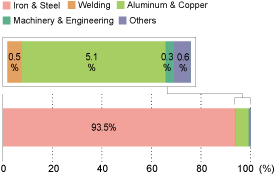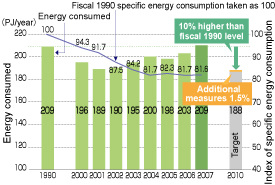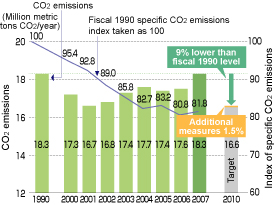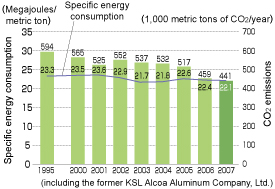Home > About Us > Corporate Social Responsibility > Sustainability Report > Sustainability Report 2008 > 1. Ensuring all aspects of manufacturing take the environment into account (1)
 1. Ensuring all aspects of manufacturing take the environment into account (1)
1. Ensuring all aspects of manufacturing take the environment into account (1)
| Global Warming Countermeasures |
| Global warming is affected by the increase in greenhouse gases, including CO2 and CFC substitutes. The Kyoto Protocol came into effect in 2005 and global warming countermeasures are being advanced worldwide. In Japan, legislation has been passed to promote global warming countermeasures, and various measures are being implemented. In business circles, voluntary action plans have been formulated to promote global warming countermeasures, and action is being taken in all business sectors. The Kobe Steel Group is promoting energy-saving and more rationalized use of energy through wide-ranging activities based on the voluntary action plan for each business sector. | ||||||||||||||||||||||||||||||||||||||||||||||||||||||||||||||||||||||||||||||||||||||||||||||||||||||||||||||||||||


|
||||||||||||||||||||||||||||||||||||||||||||||||||||||||||||||||||||||||||||||||||||||||||||||||||||||||||||||||||||
| Energy Savings in Logistics |
| Kobe Steel aims for the most appropriate, rapid transport of raw materials in Japan and around the world, and within plants and works, as well as for delivery of products to customers. Efficiency is being increased in logistics through greater coordination between sectors, and modal shifts-switching to means of transport requiring lower energy consumption per volume of cargo transported. | 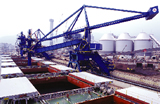 Some of Japan's largest unloaders in operation at the Shinko Kobe Power Station |
| Changes in Distribution Efficiency Activities | |
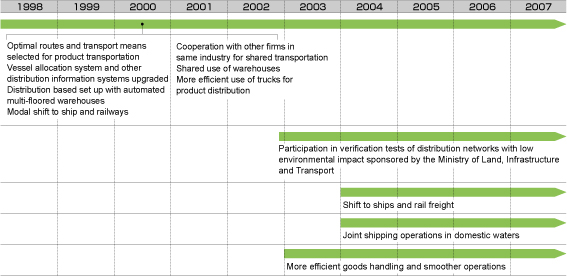
| Iron and Steel Sector | |
| Efforts have been made to improve the efficient transportation of products by selecting the optimal routes and means of transport and by upgrading information systems such as the shipping allocation system. Modal shifts in means of transport from truck to ship or rail have been pursued since 2003. Coordination with Nippon Steel and Sumitomo Metal Industries has resulted in joint operations in domestic waters and fewer journeys made by empty vessels. Measures are now being taken to boost load efficiency by combined loads in cases where one company alone cannot fill a vessel bound for a distant location. Similar efforts are being directed toward increasing efficiency of shipping operations between logistics companies in the Group. As a result of these measures, in fiscal 2007 98% of transportation of 500 km or more was by ship or rail. To maximize the benefits of the specialized large iron ore carrier Shinko Maru, that came into service between the Kakogawa and Kobe Works in March 2007, measures to increase efficiency in its operation are continuing, including improved loading and unloading. It remains an important policy for Kobe Steel to increase efficiency of operations still further in all means of transport. For transport by ship, measures include installation of improved infrastructure for loading and unloading. For land transport, efficiency of truck transportation is to be further improved. |
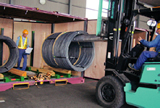 Loading wire rod into a container  The Shinko Maru |
| Welding Company | |
| The Welding Company is pursuing joint shipping with other Group companies for the transportation of its products. We are also promoting modal shifts. For example goods from the Saijo Plant in Hiroshima bound for distant Chiba are now dispatched by rail instead of truck. |
| Aluminum and Copper Company | |
| Together with joint shipping with other companies in the same business, the Aluminum and Copper Company is promoting modal shifts. Some of the truck transportation of goods from the Chofu Works in Shimonoseki to the Chubu and Kansai regions has been switched to ferry. Containers are being increased in size, and we are also improving management of transportation, and sharing information with freight companies. Some goods from the Moka Plant bound for Kyushu or Osaka have been switched from truck to JR open container rail transport. Joint application was made with the related transport companies for recognition of this as a 'Green Freight Transport Partner Project', a NEDO ancillary project aiming to reduce CO2 emissions in the distribution sector, and approval was obtained. Also, loading rates are being raised through mixed loading and using larger freight cars. At the Daian Plant mixed load transportation in mainly 10-ton freight cars has increased 5-10%. |
| Machinery and Engineering Company | |
| At the Harima Plant, simplified packaging with reinforced cardboard is used for transportation of compressors to cut packaging costs. Using recyclable reinforced cardboard instead of the former wooden skids reduces environmental burden as well as costs. To boost loading efficiency and reduce transportation costs we are promoting the mixed loading of goods for shipment and distribution, as well as chartered services. |
| Group Companies' Activities | |
| Group companies are also undertaking efforts to improve transport efficiency. |
| Examples of Activities | |
|

